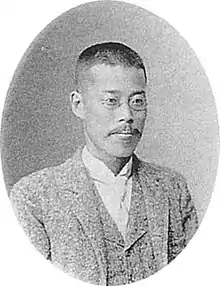Shin Hirayama | |
|---|---|
平山信 | |
 | |
| Born | October 6, 1867 |
| Died | June 2, 1945 (aged 77) |
| Alma mater | Tokyo Imperial University |
| Scientific career | |
| Fields | Astronomy |
| Notable students | Discovering 498 Tokio and 727 Nipponia |
Shin Hirayama (平山 信, Hirayama Shin, 1868–1945), also read as Makoto Hirayama, was the first Japanese astronomer to discover an asteroid. In 1900 he discovered 498 Tokio and 727 Nipponia.[1] The crater Hirayama on the Moon is jointly named after him and Kiyotsugu Hirayama.
Biography
Shin Hirayama in Edo (now Tokyo) in 1867 as the second son of a former guard of the Shogun. He was a disciple of astronomer and mathematician Hisashi Terao, and finished the course of astronomy at Tokyo Imperial University in 1890. After graduating, he was sent by to England by the Japanese government to help further his studies into astronomy. He worked on astronomical spectroscopy at the Royal Observatory in Greenwich . Several months later, he went to Potsdam, Germany where he stayed for about three years. He also attended lectures in Berlin and Leipzig during his stay in the country. During this time, he also published a paper on various diffraction patterns.[1]
When he came back to Japan in 1895, he started work as a professor of astronomy at Tokyo Imperial University where he taught practical astronomy, stellar astronomy, orbit determination, and geodesy. He later became the director of the Tokyo Astronomical Observatory in 1919.[1]
In March of 1900, Shin Hirayama discovered the 498 Tokio and 727 Nipponia, however as he was not able to determine their orbits he is not recognized as having discovered them. He was still granted naming rights over the Tokio asteroid. He also suggested "Nippon", as a name for 727 Nipponia, and its discoverer Adam Massinger named the minor planet "Nipponia" — a Latin feminized form of the word "Nippon" — in his honor.[2]
References
- 1 2 3 "The Monthly Newsletter of Royal Astronomical Society, 1947, Vol 107, pages 44-46 Obituary Shin Hirayama". articles.adsabs.harvard.edu. doi:10.1093/mnras/107.1.44. Retrieved 30 March 2022.
- ↑ Nakagiri, Masao (16 March 2012). "100 年以上前の天体写真乾板発見-その 1-(日本人最初の小惑星検出乾板の発見)" (PDF). National Astronomical Observatory of Japan (in Japanese). Retrieved 27 May 2023.
External links
- 月の命名は? at www12.plala.or.jp (in Japanese)